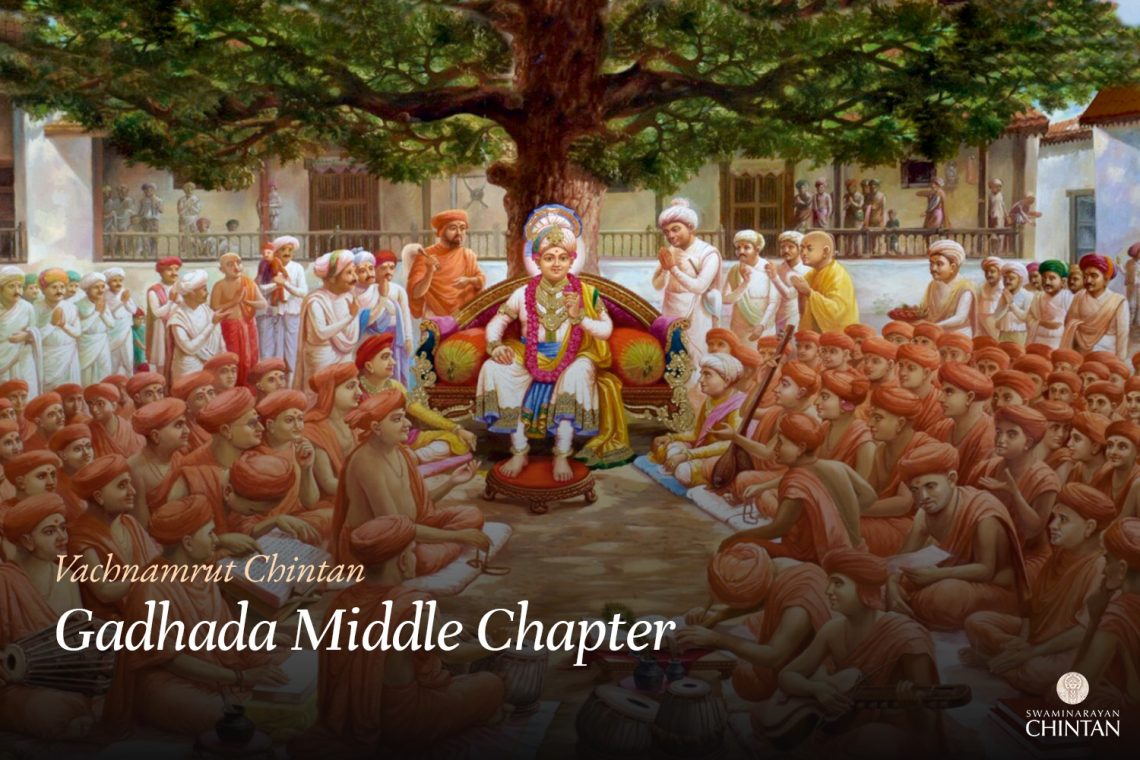Central Insights:
- Nirgun Preeti (Love beyond attributes of maya).
Key Points:
- Even if a devotee of Bhagwan transcends the gunas (qualities of material nature), there is still love for Bhagwan, and that love is sajatiya to the soul.
Explanation:
In this Vachanamrut, Shreeji Maharaj posed a question. He asked, “If a devotee of Bhagwan becomes guna-atit (transcendent of the three gunas) and behaves only as Satta (mere existence or spiritual entity), such a person is beyond Sattvagun, which brings about detachment, Rajogun, which creates attachment to the panch vishay (objects of the five senses), and Tamogun, which fosters delusion. Such a nirgun bhakta (a devotee beyond the gunas) remains in a state of detachment, like one in dreamless sleep, and is devoid of desire. Now, does such a person have love for Bhagwan or not?”
In essence, these three gunas generate attachment. As stated in the Gita: “Sattvam sukhe sanjayati” — Sattvagun binds one to happiness, Rajogun binds one to activity, and Tamogun binds one to conflict and delusion. Thus, each of the three gunas induces attachment in its own way. However, when a devotee transcends the gunas, there is no longer any factor that causes attachment or love. Hence, the question arises whether a person, who remains devoid of the gunas and rests in a state of detachment, would still have love for Bhagwan.
To this, Muktanand Swami responded, saying that even such a person, who remains in the state of Satta, still has love for Paramatma. Then Shreeji Maharaj asked, “Is this love sajatiya (similarto it’s kind) to the soul, or vijatiya (dissimilar to its kind)?” Muktanand Swami answered that love is sajatiya to the soul. The soul is of the nature of pure knowledge, and in that pure knowledge, there is a preference for something superior. When the influence of the gunas is completely absent, the soul becomes pure, and an inherent attraction towards Paramatma arises.
In relation to this, it is mentioned in the Bhagavatam in the story of Shukdevji:
आत्मारामाश्च मुनयो निर्ग्रन्था अप्युरुक्रमे।
कुर्वन्त्यहैतुकीं भक्तिमित्थम्भूतगुणो हरिः।।
Ātmārāmāś ca munayo nirgranthā apy urukrame,
kurvanti ahaitukīṁ bhaktim ittham-bhūta-guṇo hariḥ.
(1-7-10)
And:
परिनिष्ठितोऽपि नैर्गुण्ये उत्तमश्लोकलीलया।
गृहीतचेता राजर्षे आख्या न्यमदधीतवान्।।
Pariniṣṭhito ‘pi nairguṇye uttamaśloka-līlayā,
gṛhīta-cetā rājarṣe ākhyānaṁ yad adhītavān.
(2-1-9)
Shukdevji had attained the state of pure Brahm. He had no desire for worldly happiness and was absorbed in Atmananda (the bliss of the soul). Although he had reached the state of being guna-atit, he was still drawn towards the form of Paramatma (grihita cheta) and studied the Bhagavatam, singing the praises of Bhagwan’s divine actions. Thus, even though there was a complete absence of the qualities (or attributes) created by Maya, Paramatma’s form naturally generates love and devotion within a pure vessel. This love is not motivated by any worldly cause, it is pure and sajatiya to the soul. This is known as love of Brahmrup, and great acharyas have established the principle to love Paramatma by being aatmarup—Brahmrup.
Glossary
| Nirgun Preeti – Love that transcends the three gunas (Sattva, Rajas, Tamas) |
| Guna-atit – One who has transcended the three gunas A person free from the influences of Sattva, Rajas, and Tamas, who acts purely as a spiritual entity (Nirgun). |
| Satta – The pure state of existence or spiritual being A state of detachment where one exists purely as the soul, beyond the influence of the gunas. |
| Panch Vishay – Five sensory objects The worldly temptations related to sight, sound, smell, taste, and touch. |
| Sajatiya Preeti – Love that is similar or natural to the soul This refers to the inherent love a soul has for Bhagwan, which aligns with the soul’s pure, eternal nature. |
| Vijatiya Preeti – Love that is dissimilar or unnatural to the soul Refers to attachment or love driven by material qualities or worldly objects. |
| Nirgun Bhakta – Devotee beyond gunas A devotee who remains unaffected by the qualities of Maya and yet continues to love Bhagwan. |
| Atmaram – One who delights in the Self Refers to sages like Shukdevji who are absorbed in the bliss of the atma yet develop pure devotion to Bhagwan. |
| Ahaituki Bhakti – Selfless devotion Devotion to Bhagwan that is unconditional and not motivated by any material desires. |
| Brahmrup – A spiritual state in which the devotee’s attributes become like those of Brahm—pure, detached, and blissful. |
| Aatmarup – State of being like the atma Viewing oneself as the pure soul, a prerequisite for developing love for Bhagwan. |

